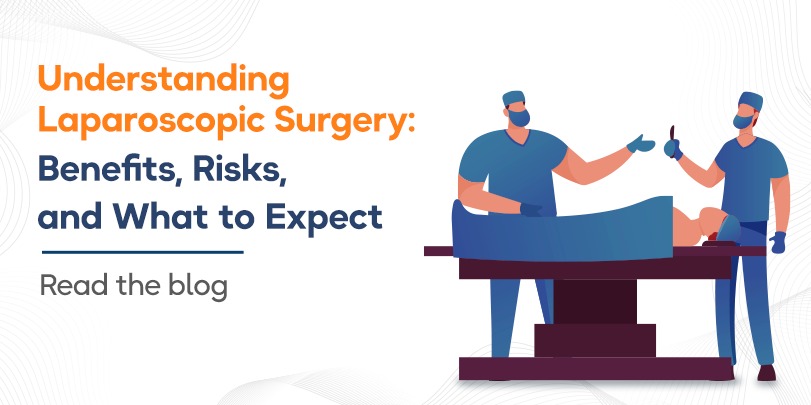


Most people have heard about laparoscopy in one way or another. Whether it is on your Facebook page, a WhatsApp group chat, or an advertisement. Or perhaps your doctor recommended it to you and here you are, researching it. If you’ve questions about the procedure, you’re at the right place. So, let’s talk about it!
The easiest way to understand laparoscopic surgery is to think of a keyhole. If you wanted to see what was happening inside a locked room, the easier way to do so – given that the door is not made of glass – is to use a keyhole. Think of your body as a locked room, your walls of skin and muscle rendering it very much opaque, not transparent. So, to look at what is going on inside without open surgery, doctors put you under anesthesia and make a small incision through which they insert a surgical tool called a laparoscope. This is a small incision near the abdomen, bowels or belly button. Your surgeon may use it to diagnose problems in the pelvis, uterus or gall bladder.
You might ask – what are the benefits of keyhole surgery, compared to a traditional surgery?
For one, it’s a surgical technique that requires just a small cut thus leading to shorter recovery time. Laparoscopy makes sure there is a tiny opening for foreign bodies to enter your abdominal, intestinal, pelvic or other vulnerable areas. This also means a lower risk of infection. Moreover, the stitches or surgical sutures that a surgeon makes on any of the areas of the body are tiny cuts which lead to less scarring.
Laparoscopic surgery will always have a faster recovery time. In fact, it should not be more than a couple of days before you can have someone drive you home. We have had patients who were free to go home the same day. We have visibly seen improved patient outcomes with minimally invasive surgical techniques. Postoperative care, when using the laparoscopic procedure, is so minimal – the instructions very easy to follow, like, you need to avoid eating – that the recovery room may not even be touched post-surgery.
Creating a working space inside the body upon which surgeries can be performed thanks to a video camera and the surgeon’s ability to see inside your body on a video monitor – and magnify anything they need to – makes for surgeries that are overwhelmingly successful. In diagnostic laparoscopy, depending on the type of surgery out of the various kinds of operations possible, the surgeon uses narrow instruments that give them a wide working and viewing space.
There is a vast array of laparoscopic surgery uses. Many abdominal surgeries like Bariatric surgery and intestinal surgeries are performed using laparoscopy. It is instrumental in removing a portion of the intestine – frequently used to treat digestive problems like diverticulitis or Crohn’s disease that don’t respond to medicine fixing a groyne , Different types of hernias like Umbilical Hernia, Hiatus Hernia, Inguinal Hernia etc..
A lot of people confuse laparoscopy with a biopsy but they are not always the same. Often, laparoscopy is used to diagnose various cancers, especially of the liver, pancreas, ovaries, bile duct
or gallbladder, and colorectal cancer. In this case, a small tissue is brought out and examined. This is called a biopsy.
You won’t remember the laparoscopy because it is done when you are unconscious and under general anaesthesia. You may also be able to return home within 24hrs to 48 hours after the procedure, depending upon types of procedure or surgery.
You will be instructed on how to care for your wounds before you leave the hospital, as well as when to schedule a follow-up appointment or have your stitches removed (although dissolvable stitches are often used).
You might experience some soreness or stiffness where the incisions were made for a few days following the treatment, especially if a breathing tube was required. A painkiller will be provided to you to aid with the pain.
After the surgery, some of the gas utilised to inflate your abdomen may still be present. This could result in bloating, cramps or shoulder aches because the gas might irritate your diaphragm (the breathing muscle), which can irritate shoulder nerve endings.
Once your body has absorbed the residual gas, these sensations shouldn’t last more than a day. They are therefore nothing to be concerned about.
A medical center may fail to use the right surgical instruments when performing laparoscopy. This includes trocars. The trochar, once the abdomen is inflated and the laparoscope is inserted, serves as a doorway for inserting additional tools like graspers, scissors, staplers, et cetera afterwards. Trochars also enable the escape of carbon dioxide gas or liquid from bodily organs and the abdominal cavity. These trochars may be placed in the abdominal or pelvic areas and unsanitary ones could lead to further infections or worse.
Complications resulting from a laparoscopy also include:
It is important to note that the majority of issues and risks arise due to neglect, lack of infrastructure and equipment and/or doctors who are untrained or do not specialize in laparoscopy. Like everything else in medicine, a surgeon may need years of training before he or she is able to perform laparoscopic surgery with great success rates. This is why at Radiance Hospitals, we make sure we have world-class infrastructure and equipment as well as specialists in laparoscopy. This is what makes Radiance Hospitals one of the best laparoscopic hospitals in Ahmedabad and the world over.
Love yourself enough to give yourself the best care available. Come over to Radiance Hospitals and we’ll take care of it all.
Comments